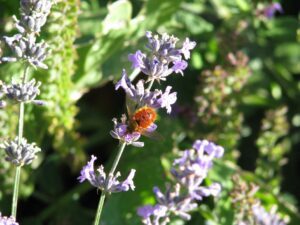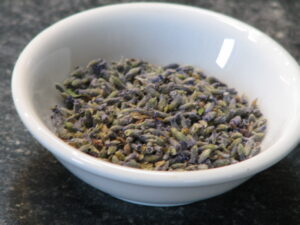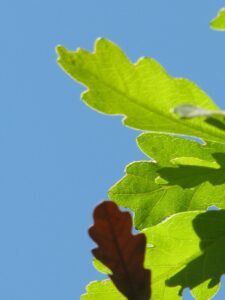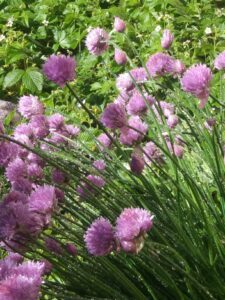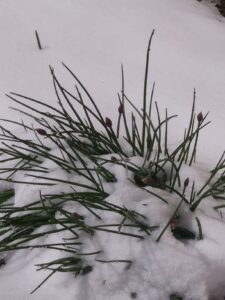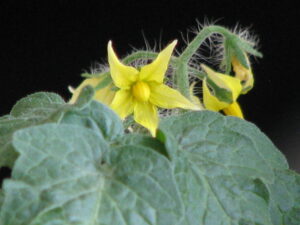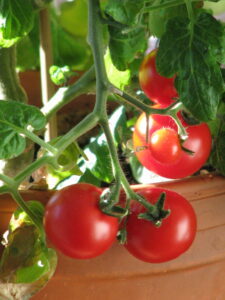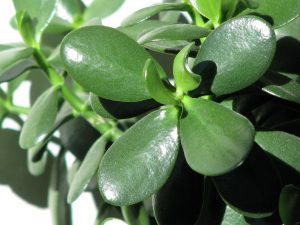Andrea M. Jones's Blog, page 2
October 1, 2021
Smells Like Cookies
High altitude gardening, in my experience, involves cultivating cool-season and quick-growing plants, but it also requires the nurturance of a certain fatalism about growing produce in a place where everything is apt to freeze around Labor Day—which is when classic garden veggies like squash and tomatoes have probably just hit their stride after their inevitable late start.
Every four or five years, though, the first autumnal frosts hold off until late September, and sometimes beyond. The temperature dropped to 32 degrees on September 21 and falling daytime temperatures have slowed the frenetic growth of the pole beans and zucchini, but the garden has not yet suffered a hard freeze.
You might think this would mean I’d walk through the gate and breathe in the essence of dirt and vegetal growth, with just a background hint of straw and hay from those leaves that, despite the lack of a killing frost, have begun to surrender to the terminal dictates of cool nights and shortening days.
Instead, I enter the garden and think about cookies.
There’s a law about unintended consequences, isn’t there? And cautionary tales about the things we should see coming but don’t?
I never expected that experimenting with lavender flowers in the kitchen would create such an incongruous response in the place where I spread horse manure and worm castings. I mean, sure, the garden is partly about growing food, although I’ve also encouraged flowers there—so much so that some of the walking paths are overrun by whatever blooming volunteer I’ve over-indulged most recently (this year is was penstemons). I love when the garden fills up with plants I’ll be able to eat, but I also like the color and texture and aromas flowers provide. It tickles me to listen to the hum as pollinators visit daisies, sage, cosmos, pansies, daylilies, and columbine, with the odd hummingbird zinging in to assess the offerings.
So, really…cookies?
Yeah. And the lavender doesn’t even have to be in flower; just brushing the plant is enough to release the perfume and send my brain fantasizing about baked goods. It doesn’t help that there’s a sprawling lavender shrub immediately in front of you as you enter the garden—which is also the parent to several of the aforementioned volunteers encroaching on the pathways as you walk further in.
What’s interesting is that I haven’t made lavender cookies all that much. I’ve mixed up a batch once or twice a summer over the past couple of years, experimenting with gluten free recipes (wheat and I do not get along), with the quantity of lavender, with fresh versus dried flowers, with lemon and without. We’re talking about an aromatic and interesting now-and-again cookie here, not a staff-of-life pantry essential. But I’m intrigued, as I always am, by the possibility of using something that thrives in the garden with minimal effort on my part. And I do like the familiar yet faintly exotic flavor, and have gotten caught up in the challenge of striking the right balance: a cookie that’s quick and easy to mix up, that’s not overly sweet, that isn’t chalky, that’s floral and complex without becoming soapy.
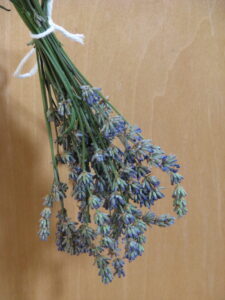
I pick stems of lavender flowers just before they open.
I’m focused on icebox cookie recipes, the dough for which I can form into a roll to freeze. I love the idea of having this stashed away should we ever again have guests, but the real beauty of it is that I can have an easily portioned sweet nosh on hand while the frozen dough puts a process—thawing, slicing, preheating the toaster oven—between my hand and cookie jar.
This all strikes me as eminently sensible, but my nose is not a pragmatist. Lavender is a potent and distinctive scent, and my brain has established a positive association between it and fresh cookies.
This is the unforeseen effect, the unintended consequence of my baking experiments—although I probably should have seen it coming. The human sensation of smell follows a simple neural path, running more or less straight from nostrils to amygdala and hippocampus; scent is notoriously tied to emotion and memory. The animal nose helped our ancestors survive by locating, and remembering how to find, and determining as tasty, food that was edible and fresh, while cueing them to avoid the putrid and potentially toxic.
For me, it seems, there’s no turning back. My hippocampus knows what it knows: where there is lavender, there just might be dessert.
***
Almond Lavender ShortbreadThis recipe is adapted from The Gluten-Free Almond Flour Cookbook by Elana Amsterdam. The dough freezes well and the results are suitable for vegans—although not, obviously, for anyone allergic to nuts (sorry, Lisa). The cookies are rich but not overly sweet.
2 1/4 cups almond flour
1/4 cup gluten free flour mix (I like Bob’s Red Mill 1-to-1 Baking Flour here; a starchy mix helps the cookies hold together)
1/2 teaspoon salt
1/4 teaspoon baking soda
1-2 tablespoons dried lavender florets, to taste and depending on the potency of your supply
7 tablespoons (scant 1/2 cup) grapeseed oil
5 tablespoons agave nectar
1 teaspoon vanilla extract
Combine dry ingredients in a large bowl. In a medium bowl, whisk together oil, agave, and vanilla, then stir into the dry ingredients until well combined. Roll the dough into a log about 2 inches in diameter and wrap in waxed or parchment paper. Freeze until firm, at least 1 hour. Slice thin (1/8”) with a wet knife. Place slices baking sheets (original recipe calls for lining them with parchment, but I’ve never bothered and everything works out fine) in a 350 degree oven. Leave the cookies on the sheets to cool thoroughly before serving.
Lavender Icebox Cookies
A more traditional version, adapted from the basic vanilla refrigerator cookie recipe in Joy of Cooking. I’m detailing my gluten free mix here; if you can eat wheat, just swap out 1 1/2 cups of regular flour, it will make things so much easier. If you are wheat-avoidant and have a packaged flour mix you like, use it, but the blend I’ve given here yields cookies that I think have a taste and texture most reminiscent of wheat flour. Special note: if you’re adapting recipes for gluten-free purposes, reduce the sugar. Alternative flours seem to play with sugar differently than wheat flour, and will come out sickening sweet if you don’t compensate. This recipe has been adjusted.
1/2 cup unsalted butter
2/3 cup brown sugar
1 beaten egg
1 teaspoon vanilla
2/3 cup oat flour
1/3 cup almond flour
1/4 cup chickpea flour OR Bob’s Red Mill All Purpose Flour (red package)
1/4 cup starchy gluten free flour mix, such as Bob’s Red Mill 1-to-1 Baking Flour (blue package)
1/4 teaspoon salt
1 1/2 teaspoons baking powder
1-2 tablespoons dried lavender florets, to taste and depending on the potency of your supply
Cream butter until soft. Blend in sugar until creamy, then beat in the egg and vanilla. In a separate bowl, mix dry ingredients except lavender; add to butter/sugar and mix until smooth. Stir in lavender. The dough is sticky, so parchment paper works better for rolling here. Chill log until firm, slice thin, and bake at 375 degrees for 7 to 9 minutes.
If you’re using frozen dough from either recipe, set it out for 15 to 20 minutes before slicing off however many cookies you want to bake with a sharp knife. Baking temperatures/times are the same.
September 9, 2021
…And Home
Travel, even for reasons as simplistically goal-oriented as arriving on your mom’s doorstep to give her a hug for the first time in almost two years, puts a frame around a period in life. Whether for a few days or a fortnight or a month, your perspective shifts, your views change, and you’re forced out of the ruts of pattern, habit, and routine.
The other thing about travel (as opposed to moving or relocating), of course, is that even as doing so involves going away, it also implies return.
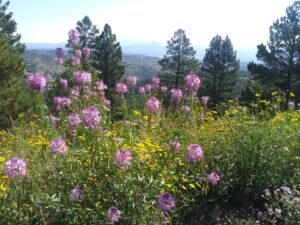
A long time coming: I’ve been trying to get wildflowers established in this bed near the garage for years.
Coming home from our July vacation was a different sort of pleasure than the trip itself. I was glad not to be in motion, happy not to be focused on the details of navigation or parking or finding a place to eat or deciding whether we should pull into the next gas station or rest stop. To arrive home after a long drive to check in with the horses and garden (all ably cared for while we were away), and then crawl into our familiar bed in the quiet dark of the mountain summer—windows open, no need for a fan or AC—was its own kind of luxury. As grateful as I was for having the opportunity to travel and to visit distant family, I was relieved to be back to my home place.
If travel shifts the perceptual frame, return boomerangs our attention to the familiar with senses un-desensitized. Home again is home refreshed. I know I’m spoiled, know I’m privileged to live where I do, but to arrive here after a long traverse across a good portion of the country to think, It’s so beautiful, and There’s no place I’d rather be was an unexpected finale for the trip.
My gratitude was no doubt heightened by the stresses of pandemic life. Ongoing uncertainty and the hovering sense that even minor public interactions are now wired with hair triggers that may backfire in unsettling ways made being home its own form of relaxation.

The garden, exuberant despite the smoke haze.
It helped, too, that we returned to the continuation of a beautiful summer. The weather had made it both easier and harder to go away: conditions weren’t so dry we were reluctant to leave lest things spontaneously combust while we were gone, but it also felt like a shame not to be around to bear witness to abundance. The grass greened in May, then, watered by a sufficient monsoon, launched glossy stems to flower and set seed. By August, the grasses were curing, more straw-gold than green, but they retained their silken shimmer and still were flecked with the white, yellow, purple, and orange of wildflowers. Patches where I’ve been seeding and transplanting for years finally erupted in botanical fireworks. The garden thrived. The horses, to put it bluntly, grew fat.
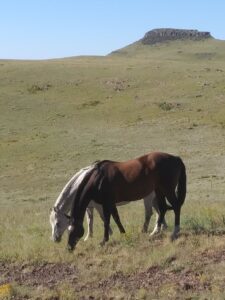
Fat and happy.
Twenty years ago, in 2001, we were living twelve miles away in Guffey while we built the barn, cabin, and walled garden. During the week I would commute to “our place” to look in on construction and wander the land, beginning my acquaintance with the topography and geology, the flora and fauna. Most weekends, we drove back to Boulder, where our house in Fourmile Canyon was for sale. I would do laundry, run errands, pay bills, sleep in our familiar bed.
Thinking back on that summer from the distance of two decades, it’s funny how vague the Boulder leg of our itineracy seems now. Is it because those weekends were taken up by the unremarkable routines that so easily overfill our days, or is it that my time at Cap Rock was doing double duty: filling my perceptions with the fresh novelty of terrain traveled-to, while already laying down the patterns of comfort, security, and attachment I associate with home?
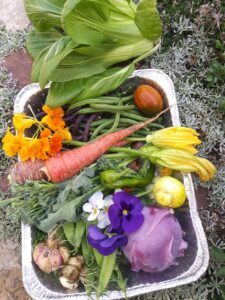
Labor Day weekend harvest, before I got around to the kale, rhubarb, cherry tomatoes, and strawberries.
August 4, 2021
Away…
Like many Americans, Doug and I recently decided it was time to slingshot ourselves out of the near-to-home orbit we’ve kept to for the past year and a half. Breaking away was not irrelevant, but mostly we wanted to check in with distant family members. I needed to hug my Mom, to lay eyes on my brother and brother-in-law without the interventions of technology. With all parties fully vaccinated and a relative lull in virus activity at either end of our planned itinerary, we hit the road, aiming for New Jersey and New York.

Manhattan skyline from Williamsburg, in Brooklyn. When my brother first moved to the neighborhood more than twenty years ago, it was not trendy, warehouses commanded the waterfront, and the Chrysler building was a prominent feature on the far side of the water.
This wasn’t a resort vacation getaway or an international trip to a bucket list destination. The road trip we embarked on was the sort we might have taken as college students, decades ago: too many miles in too few days. Getting there, we drove fast, for long hours. Back East, we hugged, ate, drank, laughed, talked. Then we got back in the car and retraced the same hard-driving, coldly efficient route home.

Brooklyn Bridge from the ferry.
I had anticipated feeling some regret about our decision to drive. The speed of flying makes it the easy default, even with the associated hassles. I worried I would feel like I’d cheated myself of time with loved ones, that the grip of driving would leave us more stressed and wrung out at the end than we were when we left.
The drive was long, and we arrived home weary, no question. Re-entry into regular life has been a scramble, trying to catch up and pick up the thread of projects dropped. But that’s how it is with any vacation. Last year we tried taking a week “off” at home, and even without any traveling at all, I don’t recall emerging particularly refreshed.
What I miscalculated about our recent journey was how much I would value those days in the car with Doug. Turns out I wasn’t cheated out of time with loved ones after all: in fact, it felt like I had two trips, one taken up with visiting distant relatives and the other an old-style road trip with my honey.
It might not have been the ultimate in quality time together, but in the ongoing uncertainty of pandemic life, being cocooned together in the car was a peculiar kind of comfort. There were no chores, no phone calls, no one else to answer to, no one else’s outrage to contend with. We talked, we listened to music, we watched the panorama beyond the windows in its slo-mo shift from foothills to plains to densely wooded roadsides and then back again, the backdrop punctuated by the odd cityscape and variations on those all-American landscape features, the truck stop and the strip mall. This trip, perhaps more than any other vacation we’ve taken in years, was a reminder that one of the reasons we like to travel is that we spend time together doing it.
June 30, 2021
Last of the Green
They come out late—latest, I guess you could say. They green up after all the bunch grasses, after the aspens. They’re later to leaf out than the other shrubs: the currants, the mountain mahogany, the ninebark, the rabbitbrush, the mountain spray. They emerge after the blue grama, too, a warm-season grass that bides its time before sprouting low mats of fine gray-green blades.
The leaves of the scrub oak—aka Gambel oak, Quercus gambelii—are in no rush. At our elevation, they unfurl after some of our wildflowers have already wrapped up their blooming business and set seed. Some years, their leafing-out seems to push to the extreme far end of spring, barely making it under the wire of the summer solstice. In the paint-by-number of vernal emergence, patches of scrub oak are the last to be re-tinted.
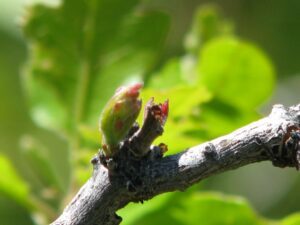
Budding oak on June 11.
In this part of Colorado, on the eastern side of the continental divide, it seems fair to describe the spring of 2021 as miraculous. Weekly pulses of precipitation, starting with snow but ending with thunderstorms, made May our wettest month since July of 2018. The shadow of drought still looms, but the land here, for now, is green. We’ve been agog at the color for weeks now, amnesiacs astounded to discover that the landscape around us can be anything other than dusty tan.
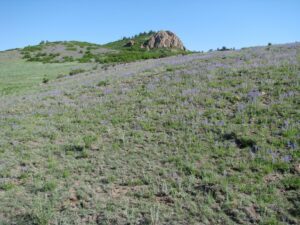
Also not tan: blue mist penstemon frosting the hillsides in mid-June, with oak brush puddling beneath the rocks.
This is, nonetheless, not the green of a wet climate: ours isn’t the emerald of England or the humid press of glossy Southern fecundity. Here, foliar green is a subdued mosaic, a patchwork of shades blended with earthy tones. Sage-tinted grasslands pool around gray rock outcrops, polka-dotted by dark pinons on south-facing slopes. Near-black stands of evergreen provide shadowy contrast. It’s up to the aspens and the scrub oak to provide the leafy-green highlights, and the scrub oak has finally colored in its patches.
With all the other vegetation already mature and sturdy, the tender green of new leaves on the scrub oak sear with their freshness. In the heat wave days of mid-June, before the afternoon thunderclouds of a monsoon pattern began interfering with the sun’s overhead glare, the oak brush was like a mirage, a teasing memory of cool refreshment.
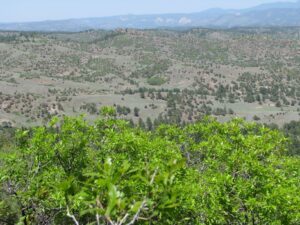
A smoke-hazy day in June.
That spring green is deepening as I write, its vibrancy seasoning to a darker, more businesslike hue. The shift lacks the flare and drama of fall and there’s no way to track its day-to-day progress with human senses. But the change is one of the steadfast rhythms that reassures and calms me if I’ve spent too much time with the news of the day. The world as we make it seems so perilous.
And I suppose it is. We live with the prospect of a future where this ritual of the oak leaves’ emergence isn’t necessarily a sure thing. But that’s a thought for some other time. For now, all urgency lies in watching the grass be green and the oak leaves quiver.
June 1, 2021
Cheers for Chives
As I’ve noted in these pages before, mine is not a subsistence garden. The growing season here is short, the high-altitude weather is extreme, the space is limited. The gardener, meanwhile, is easily distracted, typically unable or unwilling to devote the sort of effort that would a) yield an ample edible harvest, or b) preserve such bounty for later use.
The garden’s modest output doesn’t render us independent of the local grocery chain, but we enjoy a variety of homegrown produce during the growing season. We also enjoy the space itself. Walls and a sheltered location offer protection from the wind, and the plants growing within its periphery—fleshy, green, tender, well-watered—strike a vivid contrast from the tough, wiry, prickly, and drought-adapted flora that cover the ground for miles around. In a sense, the garden is just another built environment imposed on a mostly-wild landscape, yet the balance it strikes—between abundance and restriction, order and chaos, cultivated and native—is part of what makes it inviting, good for private contemplation or the company of company.
And since I don’t have extravagant expectations for productivity, whatever I harvest arrives in the kitchen already infused with an outsized sense of satisfaction. I’m weirdly smug about growing food (or herbs) without undue effort on my part—or perhaps I’m merely relieved: glad there’s something to show for the investment of time, money, and water.
The chives excel in this category. I planted a single bunch back when we were setting up the garden, probably in 2002. Other than picking them and pulling off the thatch of dead leaves in the spring, I haven’t had to do a thing to encourage them—in fact, I have to discourage them these days, by deadheading old blossoms to prevent the seeding of volunteers. Space is limited inside the garden’s walls, and I already have enough to do keeping the alpine strawberries confined to their allotted footprint.
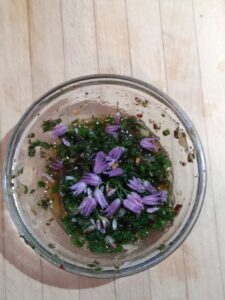
Chimichurri with chives
The chives poke up in early spring, right when I most desperately need to see something green. There’s no messing around with the chartreuse of early tender leaves, either; the first little spears are hearty, deep, mature green. Flower buds soon follow: tapered finials that will burst open as round lavender poufs. Chives don’t mind getting snowed on, and they’re impervious to frost. The occasional mouse or chipmunk that finds its way into the garden isn’t interested in them, and I can’t think of a time I had to pick a bug off a chive.
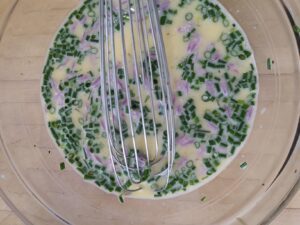
Fritatta mix with chives
I always have more than I can use, not that I don’t try. For both color and flavor, I snip chives—either leaves or florets, or both—over salads (green, tuna, potato). I garnish soups, sautés, and dips, and have developed a special keenness for sprinkling them over sandwich fillings, where they confer a slight onion zing without the lingering halitosis. They’re a must with egg-based dishes, whether scrambles, quiches, tarts, or frittatas.
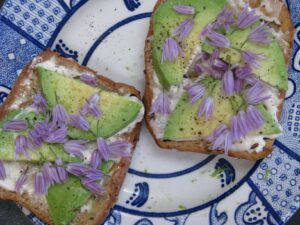
Avocado sandwich…with chives
I even have a recipe for a beet and goat cheese dip, the success of which depends on chives—so much so that I don’t tend to make it in winter because I think it’s just so much better with “my” chives. I like to make it for guests because it’s simple, delicious (so long as you don’t have anything against beets or goat cheese), and in-your-face colorful. I don’t have any photos of the final product, but maybe that’s just as well. If you decide to make it, the outrageous fuchsia shade will be yours to discover.
As jotted down from whatever book or magazine I got it from, my copy of the recipe reads “Beet dip: goat cheese, sour cream, pureed beets, chive, thyme.” Since that’s perhaps not entirely helpful, here’s a more detailed version. You need to plan ahead for roasting the beets (for about an hour), but otherwise this comes together in a snap. I’ve never found the thyme to be particularly helpful to this dish and so leave it out, but if you like the flavor, by all means mince some up and toss it in. Quantities are rough; you can play with the ratio of cheese to beets, both to please your palate and adjust the color of the finished product.
Beet and Goat Cheese Dip
2 to 3 medium-sized beets, roasted until tender then cooled
8 oz. plain goat cheese
2 tablespoons sour cream OR Greek yogurt
2-3 tablespoons minced fresh chives
Chop the roasted beets in a food processor until fine/pureed. Add the goat cheese and blend until smooth, then stir in the sour cream or yogurt and chives. The cheese will most likely provide all the salt you need, but adjust to taste. Garnish with additional chives, or chive florets.
As we begin to contemplate interacting with people from outside our households, I urge you to give it a whirl. Just make sure you don’t leave out the fresh chives.
May 9, 2021
Lichen-Looking
They’re common as grass up here, and far more populous than trees. Lichens are everywhere, although I mostly notice them on rocks. Their ubiquity works against them, I suppose, makes it easy to skim past them with quick categorizing glances: the frilly pale green lichen, that orange one, the fluorescent lime variety. They’re also small and low to the ground—so much so that in some cases they are the ground.
Since it’s hard to march purposefully over rocks, I tend to steer around the places where lichen are most prominent, particularly if I’m going out to catch a horse or trying to get blood circulating after too much sitting. As a result, there are plenty of areas, including spots near the house, where I don’t spent a lot of time. I began aiming for rocky patches a few weeks ago, however, seeking in them refreshment of novelty after months of seeing the same dormant grasses and winter-bound evergreens.
I’ve decided that lichenology is like astronomy. Both are studies of realms from which the observer is distanced by disunity of scale and improbable lifeways. As you might expect from organisms that function as symbiotic partnerships between fungus and algae, the biology gets a bit involved, so I hope you’ll allow me to stick to superficial elements. After all, that’s what lichens do.
When I say lichens are everywhere, I mean everywhere, not just all over the place here where I live, but all over the world. They grow on rocks and trees and walls and dirt, doing so in deserts, on the tundra, on coastal shores, on mountaintops, on waste sites. They can dissolve rocks (albeit slowly), creating soil out of stone. As pioneer species, they’re often the first to brave destruction zones. Of the thousands of known species, about a thousand occur in the Rocky Mountains. Most of these are so small they cannot be identified without a microscope, and are presumably often mistaken for the materials they colonize.
My 1998 Lone Pine field guide, Plants of the Rocky Mountains, forgoes Latinate terms such as “squamulose” or “filamentous” for a more poetic scheme to characterize growth forms: dust, crust, scale, leaf, club, shrub, and hair. Lichens incline us to the poetic, it seems, their oddness urging a symbiotic partnership of the literal and the metaphorical in talking about them. Far more so than with birds or plants, the common names for lichen veer toward whimsy: Sockeye scale, Blistered rocktripe, Freckle pelt, Pink-eyed rockbright, Powdered paw, Peppered vinyl, Brown-eyed sunshine, Weathered ruffle, Ragged snow, Colorado rockfrog, Pincushion orange, Rockworm, Peppered pixie-cup, Sugary beard, Wooly coral.

Pretty sure this one is Pink-eyed rockbright (Rhizoplaca chrysoleuca)
The shape of their parts and their growth habits are foliar, flowing, and fleshy rather than crystalline, chiseled, or mathematically angular. Beyond those generalities, however, characterizing lichen requires uncanny mashups and an utter disregard for scale. I have a hard time coming up with images for them without violating boundaries of theme or intellectual discipline. A lichen that resembles lizard skin is nestled next to a spiral galaxy, while a free-form fleur-de-lis curls, unwilted, next to a sunburst. Like a world map arranged across the bulge of boulder, I can see continents, atolls, mountain ranges, plains, and seas: landscapes within the landscape. I find myself collecting picturesque phrases as I wander: akin to miniature coral, looks like crumpled paper, reminds me of tiny fronds of sea fan. Would I describe that as a fairy cup or an impact crater? This one sandpapery, that one pocked, another freckled, others warty. Revisiting the pages of my field guide, common names that sounded cutesy and fanciful a few weeks ago now seem penetratingly exact.
Whether the fungal/algal relationship is symbiotic or parasitic (most sources lean toward the former but concede to the possibility of the latter), it results in colors that all seem to be borrowed from other classes of life and matter: sage green, rust orange, leather brown, designer taupe, mustard yellow, smoky gray, olive, graphite. The hues aren’t showy, but they are assiduous. As long as lichens are alive, they hold their color—and they live a long time. Some people believe they’re among the oldest organisms on the planet. They’re good at tolerating desiccation and bad at tolerating of air pollution, qualities that invite further reflection on the nature of my home place. In that, at least, there’s nothing unusual about lichens. Whenever I start peering closely at an aspect of the world beyond the doorstep, I soon find myself in over my head.
I’ve now lived here long enough to find little colonies—most likely Colorado rockfrog—starting to grow on flagstones we set in place when we moved here twenty years ago. Something about this warps my brain a little, but after hanging around with lichens for a while, I’m starting to get used to that.
March 29, 2021
The Jungle Indoors
On this March afternoon, clouds drift in sullen white-gray flocks, west to east. The sodden remains of last week’s blizzard litter the ground in ragged drifts, their undersides dissolving to slush faster than the tops melt under a disinterested sun. The warming ground and moisture are welcome, but the muck and disarray, on the heels of this very long winter, are not welcoming.
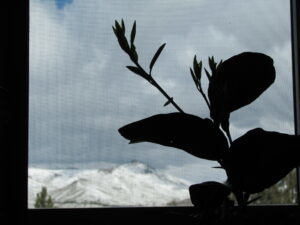
New growth inside, snow outside.
If I want greenery and the promise of another season, I won’t find it outdoors this week, not here, at this altitude. I could drive, head downhill into a different hardiness zone, go hunting for swelling buds on trees and the eager poking of fleshy leaves by other people’s tulips and daffodils.
Or I could just stay inside.
I cannot decide if they are more like pets or roommates, the houseplants. They claim space and can be messy. They’re quiet, though, unlike most pets, and don’t hog the fridge or the hot water like a roommate might. In the end, perhaps it’s the fact that I’m responsible for their care and feeding and that they sometimes piddle on the floor that tips the analogy toward housepet.
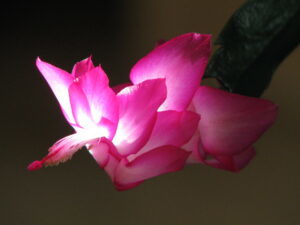
Schlumbergera bloom.
Like a dog or a cat, they’re individuals, and their histories overlap mine, in some cases for decades. I bought the little palm-like dragon tree (Dracaena marginata, I’ve recently learned) at the TG&Y in Durango, Colorado, when I was in high school in the early 1980s. It was maybe eight inches high at the time, and survived numerous moves, first to a variety of college apartments, then to Doug’s condo in Boulder and later to the house in Fourmile Canyon west of town. I farmed all our houseplants out to friends for a year and a half while we lived in the cabin here as the house was built. After we settled in and reclaimed the plants (virtually all of which survived: we have good friends), the dragon tree was probably two feet tall. I put it on the bottom stair in the basement, next to the door into the garage.
This sounds like an undistinguished location for a houseplant already of venerable age by then, but it loved that spot. Filtered morning sun shone through the walkout door across the room, then shifting rays poured down the staircase all afternoon and evening. The plant shot up, branched, spread. It grew top-heavy and toppled off the step more than once before I moved it up to my office a couple of years ago. This is another bright space, and the plant seems happy. Apparently you’re supposed to prune dragon trees, but I’ve never done so. With some creative staking, it stays upright and has achieved a distinctly Seussian form.

My elderly office-mate.
I have a similarly long history with the grape ivy, which once hung in the office of the business my parents operated in Loveland, also in the 1980s. Suspended next to an exterior door, the plant would get whipped by gusts on windy days, its plastic pot swinging wildly whenever the door opened. I adopted it when the office moved, and it lived an ordinary life until we moved into the house in Fourmile in 1996. There, on the landing at the top of the stairs, the ivy became a diva. It draped over the railing like movie star from the golden age of Hollywood making a grand entrance, drawing admiration and comments from visitors. By the time we moved, it had sprawled at least six feet wide, with tendrils reaching up and over the handrail to dangle four and five into the entryway. I had to cut it back savagely when we moved, but it survived and two decades later it maintains its figure, healthy but not extravagant. I live in fear of repotting it or providing a trellis on which it can swoon: the old prima donna might stage a comeback and take over the stairs in this significantly smaller house.
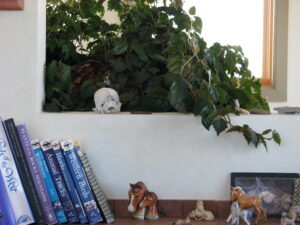
Grape ivy as seen from my desk.
The Ficus that was a gift from a boyfriend in 1988; the Schefflera and Norfolk pine Doug got for his condo not long after we started to date in 1992; the aloe, jade plant, Schlumbergera, and snake plant my Mom gave me when she moved to Brooklyn in 2001: we’ve all lived together for a long time. I appreciate that the plants are oxygenating the air, although I’m mostly grateful for their many shades of green and the wondrous geometries of their foliage. Since they are more like pets than decor, the oddly shaped and frankly ugly specimens have a home here as long as they’re alive.
Their numbers and the size of some individuals perpetuate the fiction that I’m skilled with houseplants, which can have unfortunate consequences. Well-meaning people have gifted me with beautiful but fussy or humidity-addicted plants, which I’ve accepted with thanks and a sinking heart. I know the orchid or azalea or bonsai is doomed. I can’t even keep African violets or basil alive. Plants in this house have to be tough. They need to cope with wild swings of temperature, with dry air, with unrelenting high-altitude UV, and with my irregular watering “schedule.”
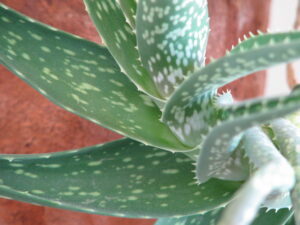
Aloe vera.
The thing is that some species don’t merely survive, don’t just thrive: they go bonkers. One tabletop-sized snake plant from Mom has now colonized two large pots that flank the patio doors, with some leaves stretching over five feet tall. I need to divide both plants again, but have nowhere to put one more monster plant, much less two. If I placed the two jade plants side-by-side they would make a serviceable hedge, and it takes regular hacking with pruners to keep them to that proportion; they also started as a single innocuous plant from Mom.
Although I’ve never succeeded with a windowsill herb garden, the pragmatist in me keeps trying with culinary plants. I’ve long coveted a Meyer lemon tree, and keep them alive just long enough to convince myself I’ll succeed someday. The current incarnation is one of the aforementioned ugly plants, most of its branches chewed off by marauding woodrats when it was out on the deck last summer. It nevertheless managed to hang on to three fruits, one of which still has a scar where a rat sampled it; evidently green lemon peel is not palatable, even in a drought. The lemons swelled gradually over the winter, and one of them has begun to ripen to yellow. Meanwhile, the tree has shot forth new sprigs at random angles and recently sprouted an enormous cluster of bead-like flower buds.
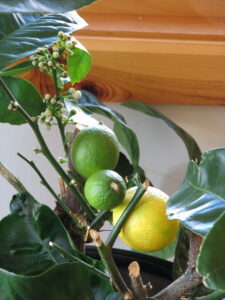
Rat-scarred Meyer lemon: not very pretty, but tough enough so far.
Also on the culinary front, I bought a ginger plant at Desert Canyon Farm last spring, which has shown a promising tolerance for neglect. A few years ago I discovered Red Robin dwarf tomato plants (also at Desert Canyon). For three years in a row now, I’ve managed to overwinter the plant I bought the previous spring. Last year’s plant was doing well on the patio table over the summer, safely elevated above rodent level, but a mule deer bellied up to the table in August and ate dozens of green fruits, along with branch tips where new flowers form. It took a while for the plant to recover enough to flower again after I moved it inside, but since late December I’ve picked a small yet steady supply of homegrown cherry tomatoes.
Some of the plants, such as the lemon tree, provide living bouquets at random intervals, but the Schlumbergera are more dependable. They take our northern-hemisphere summers off but their bright pink buds in October. They bloom in time for Mom’s birthday in early November, which is why I refer to mine as the Birthday cactus rather than the more common common name of Christmas cactus. The shocking fuschia of the flowers is mighty welcome when the snow is flying. Meanwhile, one of the snake plants recently sprouted a pale green stalk that will present a column of fine-petaled greenish-white flowers. Their abundant sticky nectar can be messy, but the perfume is so potent I’ll pause to breathe deep whenever I pass by. The scent will persist long enough, perhaps, for spring to complete its slow trek up mountains.
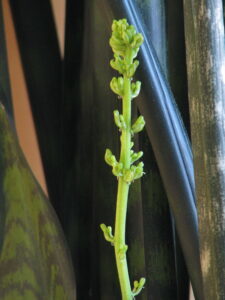
Flower stalk on the snake plant.
March 23, 2021
Watch This Space
Change is coming.
I know, I know: enough already. There’s been no end of upheaval and newsworthy and unprecedented and life-altering recently…or should that be “for ages now”? I have a hard time judging appropriate time references any more.
Anyway, if you’re not worn out and at least little stressed, congratulations. Please share your life secrets.
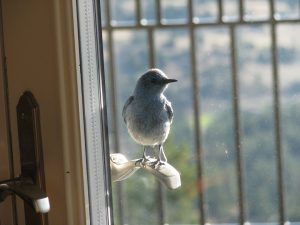
This little fellow, a male Mountain bluebird that visited the house in the fall of 2013, has been my mascot since I started the blog. He might not be headlining the updated layout, but I’ll make sure he looks in on all of us once in a while.
The Between Urban and Wild blog has been going since the fall of 2013. I appreciate faithful readers who tune in on my extreeeeeemly irregular schedule to see what’s going on up on this high ridge in central Colorado. I’ve never been great at consistency, so there are no grand plans to adhere to a more disciplined schedule, and I’ll carry on with my mostly-place-based posts.
But visually it’s time for an update, and a new look will be coming soon.
If you prefer to read on a phone or tablet, rejoice: the new site will be optimized for easy viewing on smaller devices.
You don’t have to do anything. The website address won’t change and everyone who follows on Reader or has subscribed to email notifications will get word of new posts, per usual.
My thanks to Marion Zachary of Blue Sky Designs for not only making the updated site look good but also ensuring that this isn’t idle chit-chat about a seamless experience for all of you.
See you here soon.
March 1, 2021
The Late Winter Rant
The view outside has become tiresome.
I don’t think I’m supposed to say that. I’m not a fundamentalist, but I’ve steeped myself in a tradition of natural history that holds the world as sublime: a wellspring of solace and inspiration and revitalization, source of and target for gratitude.
Such qualities are sorely needed these days, and so I started writing a post on the theme weeks ago. The rough start I made framed a dissonance between the constructed world of news and current events (the “urban” of this site’s title) and the unbuilt environment of ridgelines and woods and grasslands (the “wild” outside my door).
When I couldn’t find a way to make the neat dichotomy work, I set the piece aside, thinking a solution would come to me. I grimaced every time I glanced at the pages, though, inclined to toss them onto the shredder pile. The setup of urban discord countered by wild accord was simplistic to the point of bullflap, but the sense of persistent dissonance was…well, persistent.
I’m repelled by politics, appalled by the fissures in our public discourse, and sick of the pandemic. These things hover in the background of my days, gnawing at peace of mind with dull teeth of indistinct threat. But the fact is that my home ground is not, at the moment, a balm against any of that.
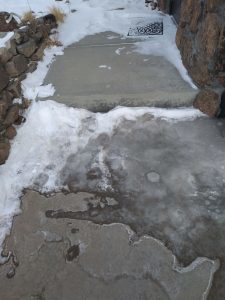
Ice…
I am sick of this gawdawful winter.
I am fed up with the wind, fed up with the ice, fed up with the pathetic excuses for snowstorms that deliver all of the hassle and cold and treacherous conditions of genuine winter storm events with none of the redeeming moisture. I’m tired of snowfalls that, too small to plow, laminate the driveway between house and barn with a packed veneer of snow that melts on the over-warm days only to freeze into ice on the over-cold ones, then is burnished to a glass-like finish by the wind. I’m tired of schlepping grit and gravel in buckets, throwing it on the glaze in an effort to avoid more ass-busting falls (two, so far this winter).
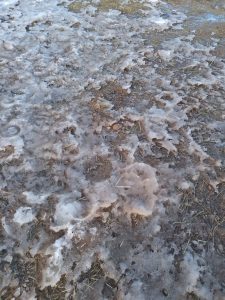
…and more ice.
I’m tired of looking at the patchwork upholstery of dull dead foliage and tattered whitish drifts; although they get covered by a thin slipcover of clean white every other week or so, it’s shredded unceremoniously by the next day’s wind.
I’m annoyed by the drips of snot that bob from my nostrils when I’m outside, incessantly tickling my nose with their fragile surface-tension grip. I’m aggrieved that taking a walk feels like a test of character. I grumble that the distant vistas might be nice if I could see them, but my eyes are constantly watering in the bitter wind.
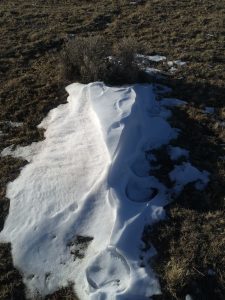
Drifts…
I bristle at the incessant rush and rustle and roar of wind as it rudely fondles the house. I curse as it penetrates my woolly hat and blasts me in the face as I come out of the barn with an armful of hay.
I’m tired of that hay blowing into my mouth as I carry it and toward Kansas or Wyoming or New Mexico after I put it down, ostensibly for the horses to eat. I’ve had it up to the gills with fishing hay out of the water tank and have grown prickly about having to pick it out of my bra (How? How does it get under my coat collar and over the top of my turtleneck??). I’m worn out from feeling sorry for the horses, as they hunker under whichever shed-roof offers the best protection, out in it day and night, manes and tails whipping.
I’m depressed at the absence of birds, the usual flock of plucky of juncos gleaning seeds from hay and horse poop and weedy roadsides this winter year a mere pair, only two.
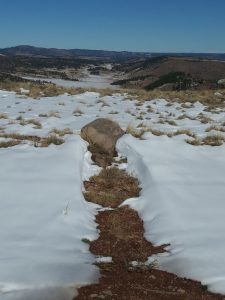
…and more drifts.
I’m sick of the damned wind. Did I mention that? The wind, wind, Wind, WIND, WIND?
These thoughts pass through my mind and I think, No, no; too much and too negative; we’ve all had enough of misery and mouthing off about how hard it all is. So many people actually DO have it hard, and I have nothing to complain about.
I have absolutely nothing to complain about. The power’s on, the well water flows, and is clean. I have jobs to do and my husband’s here, plugging along alongside me, and my other loved ones, although too far away for too long, are alive.
So I ditch dissonance and try to find something else to write about. I walk out into the pasture, maneuvering around ice and the crusty lumps of old snowdrifts, looking for color or pattern or solace or brightness or wonderment. I am struck, as always, by the lichen splashed across the rocks like green and orange paint.
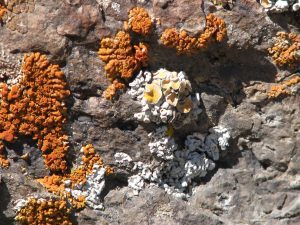 But on beginning to write, my mind veers off course; how to give context for the zingy hues without accounting for the drabness of the drab winter ground?
But on beginning to write, my mind veers off course; how to give context for the zingy hues without accounting for the drabness of the drab winter ground?
I try again, closer to home, so close I’m still inside. In the house, rooted in lives truly suspended between urban and wild, immune to the vicissitudes of weather, sheltered from the cursed wind, the houseplants nourish eyes starved for verdure. I admire the fleshy leaves of the succulents and the feisty tendrils on the ivy and the saucy lipstick buds on the Schlumbergera. The Meyer lemon, pruned to a frankly ugly form by gnawing rodents last summer out on the deck, nevertheless sports a cluster of green lemons and is working up a bumper crop of new flower buds.
Write about that, about the jungle indoors.
But first, for context, I write:
The view outside has become tiresome….
The Late Winter Rant
The view outside has become tiresome.
I don’t think I’m supposed to say that. I’m not a fundamentalist, but I’ve steeped myself in a tradition of natural history that holds the world as sublime: a wellspring of solace and inspiration and revitalization, source of and target for gratitude.
Such qualities are sorely needed these days, and so I started writing a post on the theme weeks ago. The rough start I made framed a dissonance between the constructed world of news and current events (the “urban” of this site’s title) and the unbuilt environment of ridgelines and woods and grasslands (the “wild” outside my door).
When I couldn’t find a way to make the neat dichotomy work, I set the piece aside, thinking a solution would come to me. I grimaced every time I glanced at the pages, though, inclined to toss them onto the shredder pile. The setup of urban discord countered by wild accord was simplistic to the point of bullflap, but the sense of persistent dissonance was…well, persistent.
I’m repelled by politics, appalled by the fissures in our public discourse, and sick of the pandemic. These things hover in the background of my days, gnawing at peace of mind with dull teeth of indistinct threat. But the fact is that my home ground is not, at the moment, a balm against any of that.
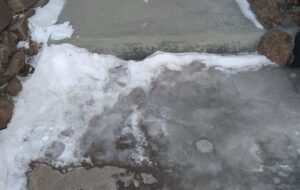
Ice…
I am sick of this gawdawful winter.
I am fed up with the wind, fed up with the ice, fed up with the pathetic excuses for snowstorms that deliver all of the hassle and cold and treacherous conditions of genuine winter storm events with none of the redeeming moisture. I’m tired of snowfalls that, too small to plow, laminate the driveway between house and barn with a packed veneer of snow that melts on the over-warm days only to freeze into ice on the over-cold ones, then is burnished to a glass-like finish by the wind. I’m tired of schlepping grit and gravel in buckets, throwing it on the glaze in an effort to avoid more ass-busting falls (two, so far this winter).
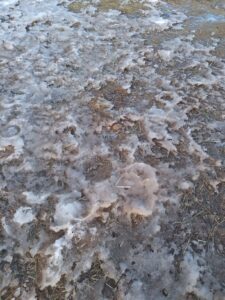
…and more ice.
I’m tired of looking at the patchwork upholstery of dull dead foliage and tattered whitish drifts; although they get covered by a thin slipcover of clean white every other week or so, it’s shredded unceremoniously by the next day’s wind.
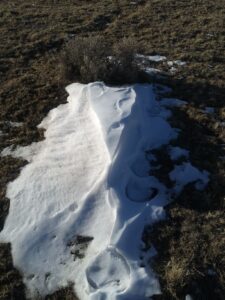
Drifts…
I’m annoyed by the drips of snot that bob from my nostrils when I’m outside, incessantly tickling my nose with their fragile surface-tension grip. I’m aggrieved that taking a walk feels like a test of character. I grumble that the distant vistas might be nice if I could see them, but my eyes are constantly watering in the bitter wind.
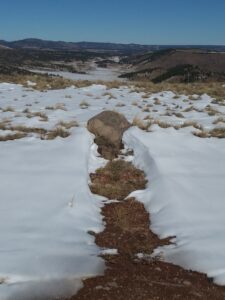
…and more drifts.
I bristle at the incessant rush and rustle and roar of wind as it rudely fondles the house. I curse as it penetrates my woolly hat and blasts me in the face as I come out of the barn with an armful of hay.
I’m tired of that hay blowing into my mouth as I carry it and toward Kansas or Wyoming or New Mexico after I put it down, ostensibly for the horses to eat. I’ve had it up to the gills with fishing hay out of the water tank and have grown prickly about having to pick it out of my bra (How? How does it get under my coat collar and over the top of my turtleneck??). I’m worn out from feeling sorry for the horses, as they hunker under whichever shed-roof offers the best protection, out in it day and night, manes and tails whipping.
I’m depressed at the absence of birds, the usual flock of plucky of juncos gleaning seeds from hay and horse poop and weedy roadsides this winter year a mere pair, only two.
I’m sick of the damned wind. Did I mention that? The wind, wind, Wind, WIND, WIND?
These thoughts pass through my mind and I think, No, no; too much and too negative; we’ve all had enough of misery and mouthing off about how hard it all is. So many people actually DO have it hard, and I have nothing to complain about.
I have absolutely nothing to complain about. The power’s on, the well water flows, and is clean. I have jobs to do and my husband’s here, plugging along alongside me, and my other loved ones, although too far away for too long, are alive.
So I ditch dissonance and try to find something else to write about. I walk out into the pasture, maneuvering around ice and the crusty lumps of old snowdrifts, looking for color or pattern or solace or brightness or wonderment. I am struck, as always, by the lichen splashed across the rocks like green and orange paint.
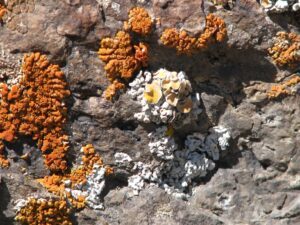
Lichen garden.
But on beginning to write, my mind veers off course; how to give context for the zingy hues without accounting for the drabness of the drab winter ground?
I try again, closer to home, so close I’m still inside. In the house, rooted in lives truly suspended between urban and wild, immune to the vicissitudes of weather, sheltered from the cursed wind, the houseplants nourish eyes starved for verdure. I admire the fleshy leaves of the succulents and the feisty tendrils on the ivy and the saucy lipstick buds on the Schlumbergera. The Meyer lemon, pruned to a frankly ugly form by gnawing rodents last summer out on the deck, nevertheless sports a cluster of green lemons and is working up a bumper crop of new flower buds.
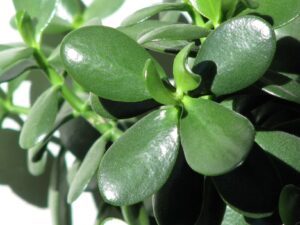
Green. I remember green.
Yes.
Write about that, about the jungle indoors.
But first, for context, I write:
The view outside has become tiresome….

